Edinburgh
1 - City and Royal Mile
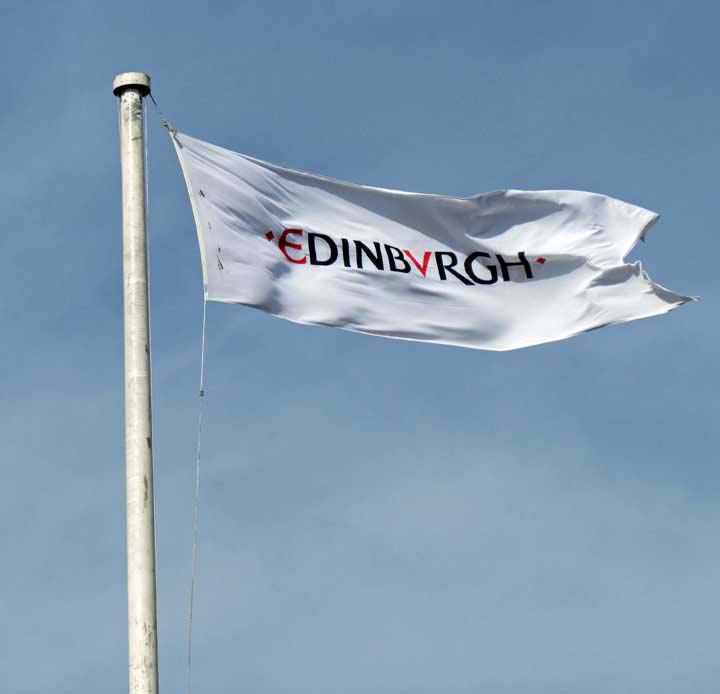
Edinburgh is the capital city of
Scotland, the second
largest city in Scotland, and the eight
most populous in the United Kingdom. Edinburgh is the seat of the Scottish Parliament. The city is
one of the historical major centers of Scotland helping to earn it the nickname Athens
of the North. The Old Town and New Town districts of Edinburgh were listed as a
UNESCO
World Heritage Site in 1995 in
recognition of the unique character of the Medieval Old Town.
The city hosts the annual Edinburgh Festival, a group of
official and independent festivals held annually over about four weeks beginning
in early August. The number of visitors attracted to Edinburgh for the Festival
is roughly equal to the settled population of the city.
Edinburgh Castle
The first evidence of the existence of the town as a
separate entity from the fort lies in an early 12th century
royal charter,
generally thought to date from 1124, by
King David I granting land to the Church
of the Holy Rood of Edinburgh. This suggests that the town came into
official existence between 1018 and 1124.
By the 12th century, Edinburgh was well established,
founded upon the famous castle rock, the volcanic crag
and tall
geological feature shaped by 2 million years of glacial activity. Flourishing
alongside it to the east, another community developed around the Abby
of Holyrood,
known as Canongate.
In the 12th century these both became Royal
Burghs
and through the late medieval period Edinburgh grew quickly.
Edinburgh in the 17th century
In 1603,
King
James VI
of Scotland succeeded to the English and
Irish
thrones, uniting the Kingdoms in a
personal union
known as the Union
of the Crowns. Scotland remained an independent state with the Parliament
of Scotland in Edinburgh. King James VI progressed to London,
establishing there his court from which he reigned over his kingdoms. Despite
promising to return every three years, he returned to Edinburgh only once, in
1617.
In 17th century Edinburgh a defensive wall, built in the
16th century largely as protection against English invasion following James IV's
defeat at the Battle
of Flodden
and hence named the Flodden Wall, still defined the boundaries of the city. Due
to the restricted land area available for development, houses increased in
height instead. Buildings of 11 stories were common and there are records of
buildings as high as 14 or even 15 stories, an early version of the modern-day
skyscraper. Many of the stone-built structures can still be seen today in the
Old Town.
In Edinburgh the
Hanoverian Monarch
attempted to gain favor by supporting new developments to the north of the
castle, naming streets in honor of the King and his family; George Street,
Frederick Street, Hanover Street and Princess Street, named in honors of George
III's two sons.
Royal Mile
As the name suggests, the Royal Mile is approximately one
Scots
mile long, and runs
between two foci of history in Scotland, from
Edinburgh Castle at the top of the Castle
Rock down to Holyrood
Abby. The Royal Mile is Edinburgh Old Town's busiest tourist street, rivaled only by
Princess Street in the New Town.
Retreating ice sheets,
many millennia ago, deposited their glacial
debris behind the hard volcanic
plug that is Castle Rock (which Edinburgh Castle sits upon), resulting in a distinctive
crag
and tail feature. Extending in an eastwards direction, the Royal Mile sits upon the
spine of this crag and tail trailing gently down from the Castle to the Palace
of Holyroddenhouse.
Steep closes
(or alleyways) run between the many tall lands (or tenement buildings)
off the main thoroughfare.
Looking
up the Royal Mile towards the Castle
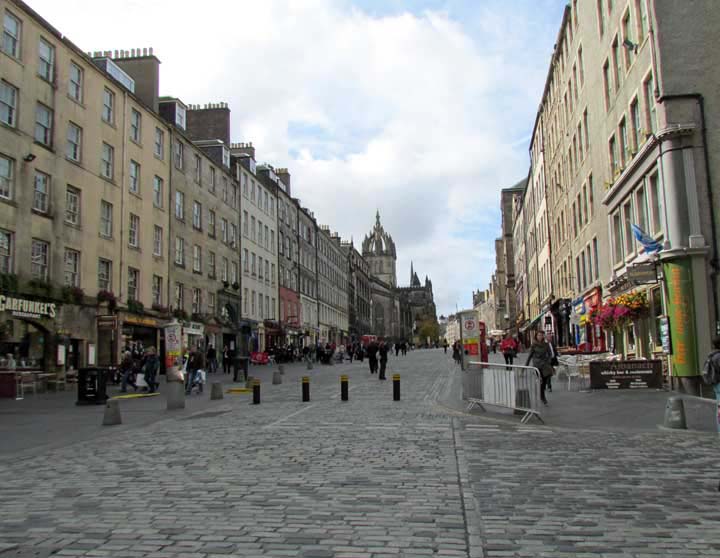
Looking
down the Royal Mile towards Holyrood Abby
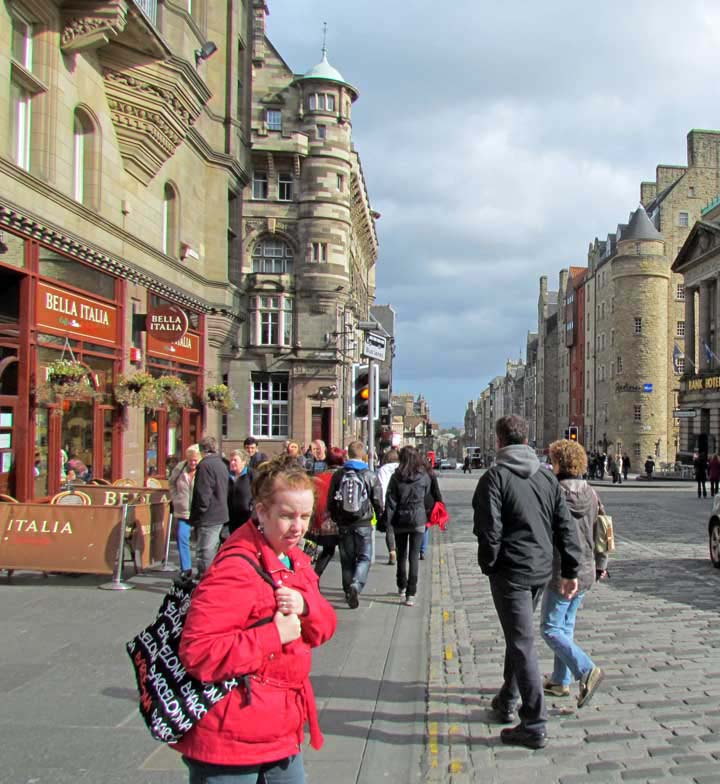
The
street we walked up from the rail station
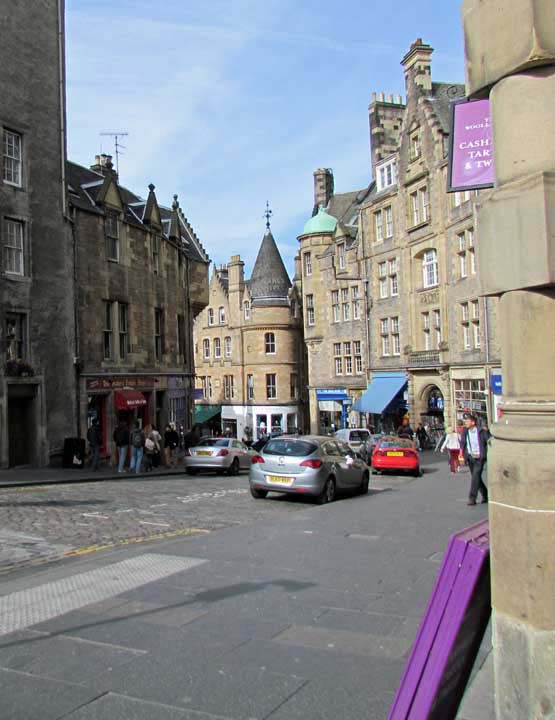
There
were colorful wildlife fiberglass statues
up
and down the royal Mile. As in cities here
in
the states, they were used to raise funds.
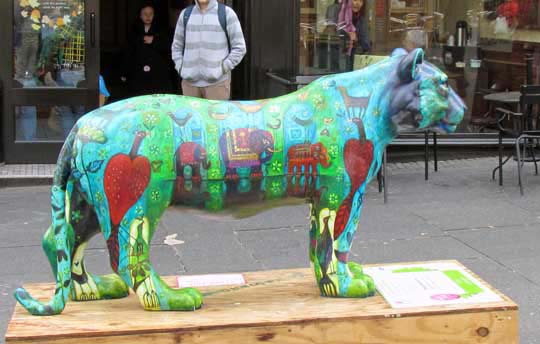
There
are narrow alleys branching off the Royal Mile, much as ribs from a spine,
called close's .
Much
more on these later.
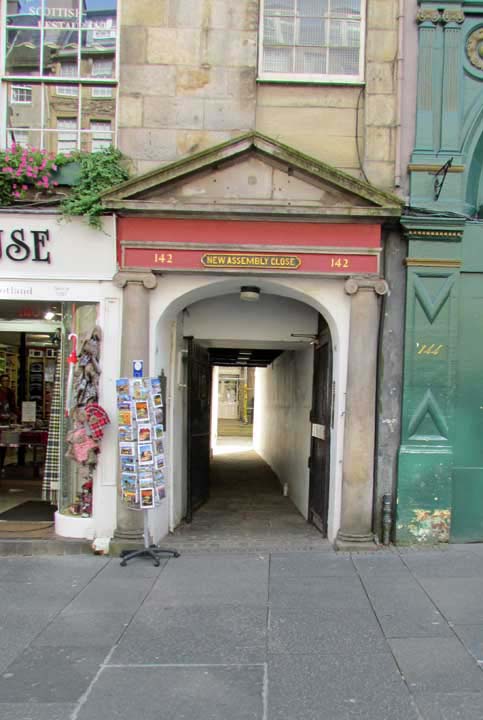
Street
performers amuse the tourists
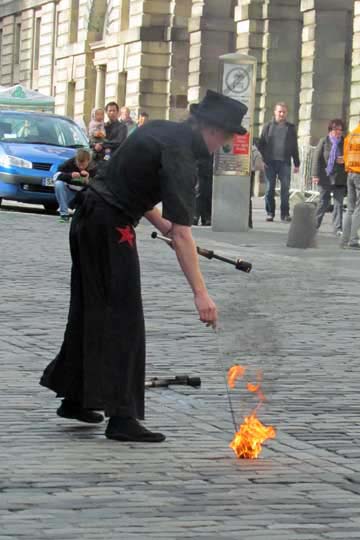
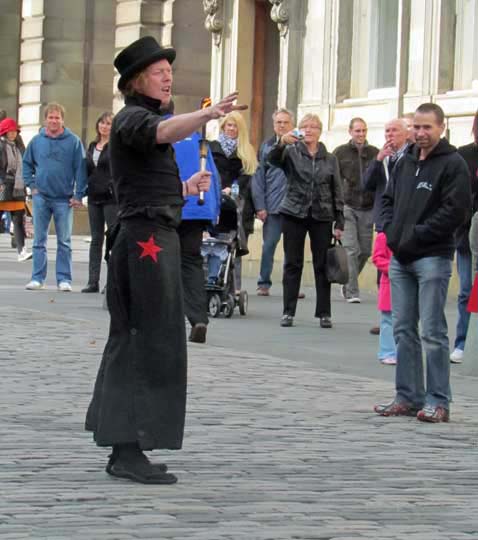
Again,
the wildlife models - no more mention of them - just pictures
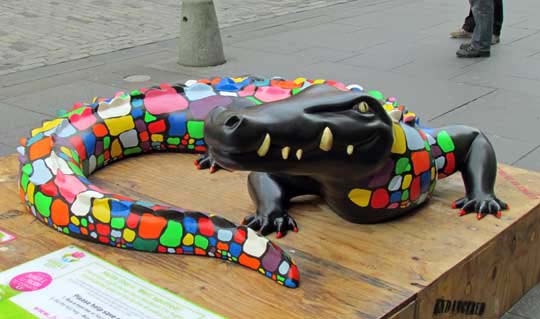
Adam
Smith guards the Mile
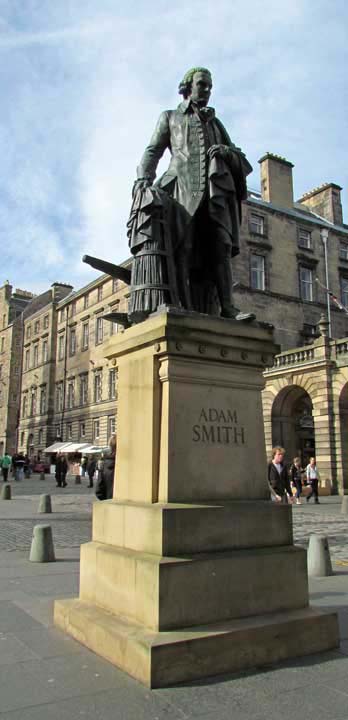
Ah,
phone boxes make me homesick for London
And
Subway reminds me of Ugh!
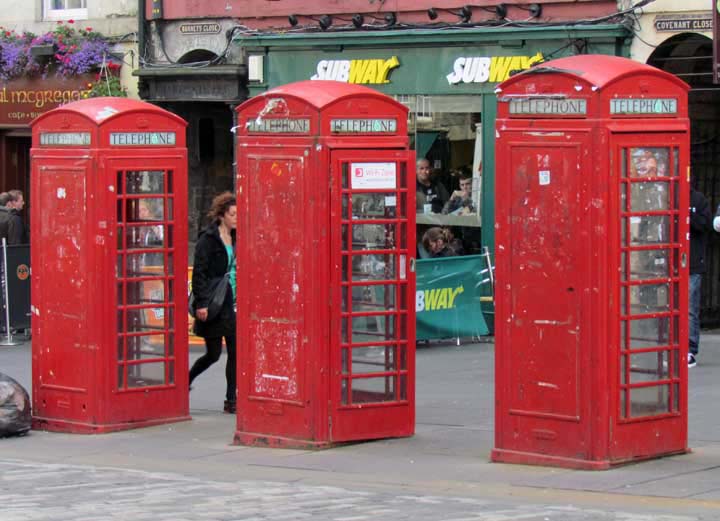
The
original wellhead - damaged by a horse drawn fire engine and rebuilt
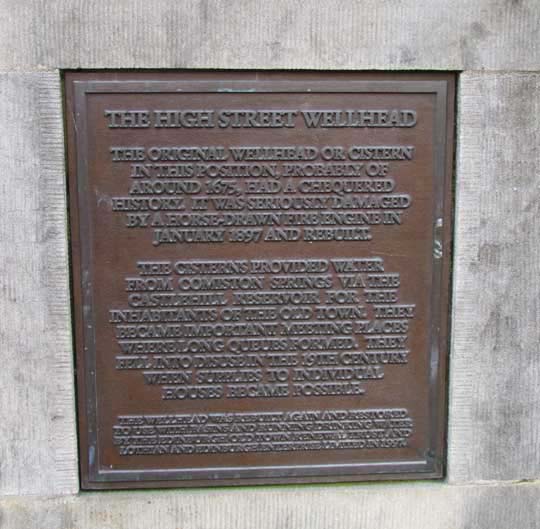
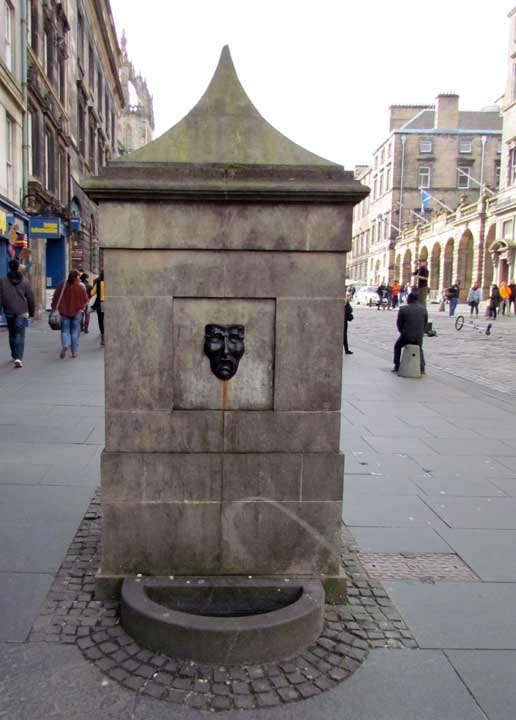
The
Merker Tower
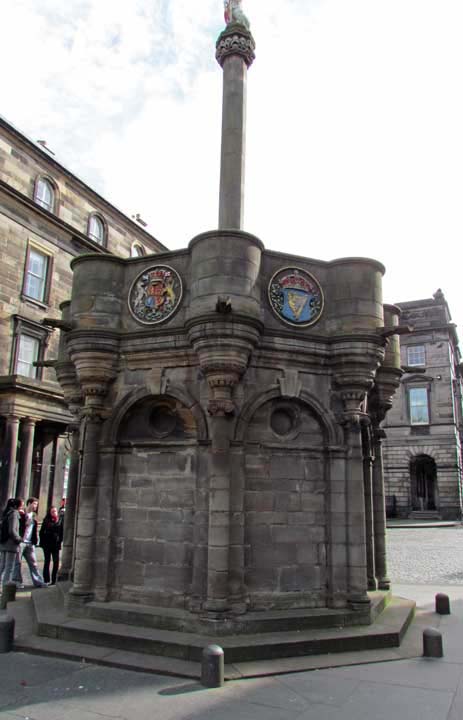
All
the walking tours start here - run by "Merker Tours", of course.
A
very interesting tower. You will see it pictured and in background several
times. This tower has a locked door in front of a stair well leading to
the level above the ensigns. This original structure was used to make
Royal announcements. Today, it is still used for those occasions.
For example when the marriage of Prince William was formally announced.
the announcements are always made by a officials in historical
costume.
Because
it took three days for work of a Royal Announcement to reach Edinburgh, to this
day, when a Royal Statement is made in London, the announcement from Merker
Tower is made three days later.
These
Scots truly appreciate history!
Newer
government building across from Merker tower
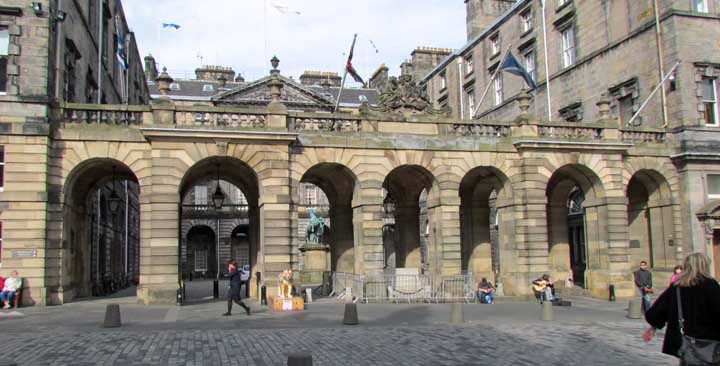
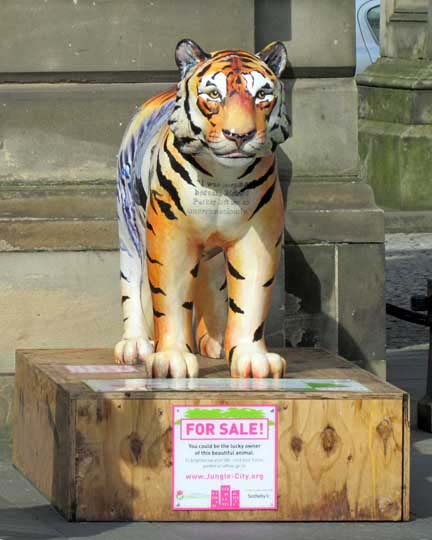
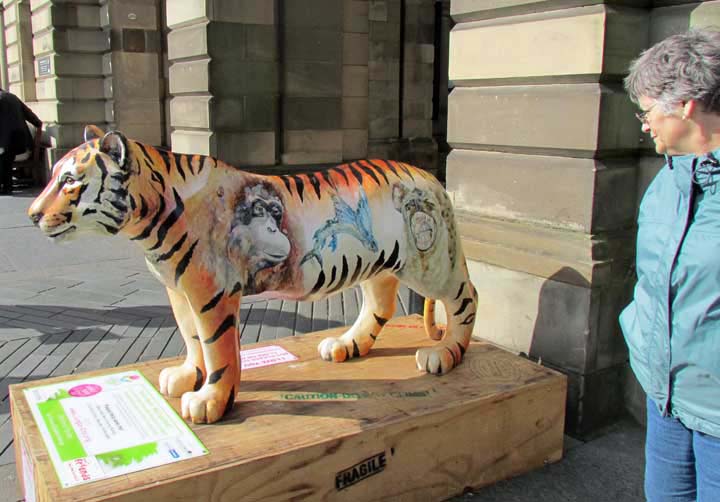
Our
Royal Mile guide, meeting her group at Merker Tower
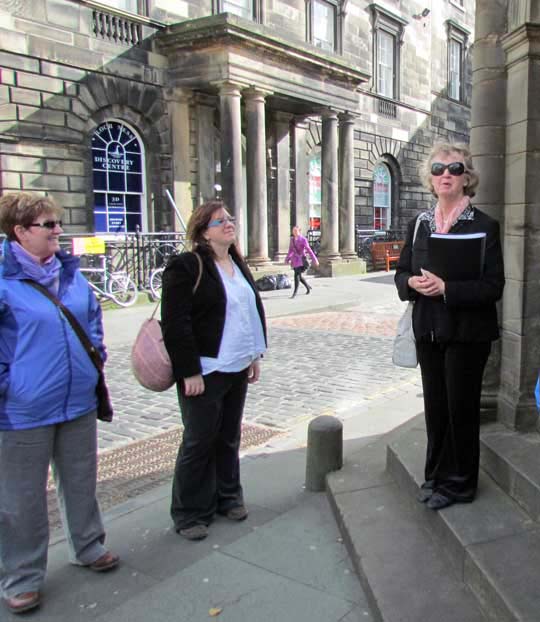
Close
up of Merker - showing Royal insignia
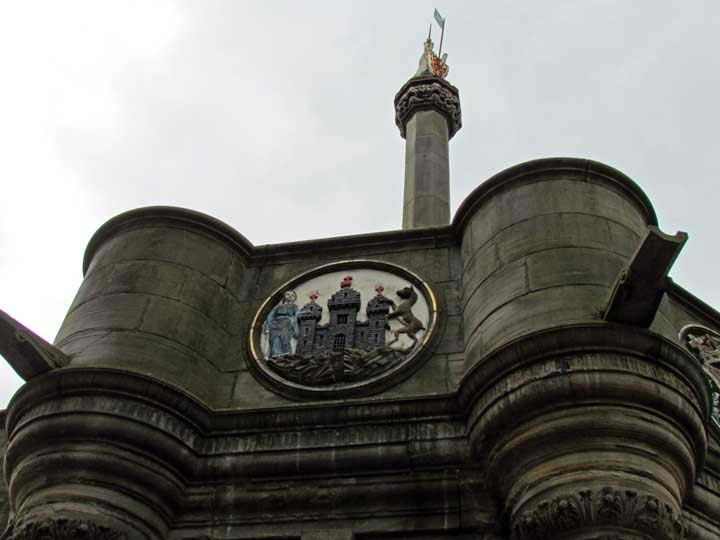
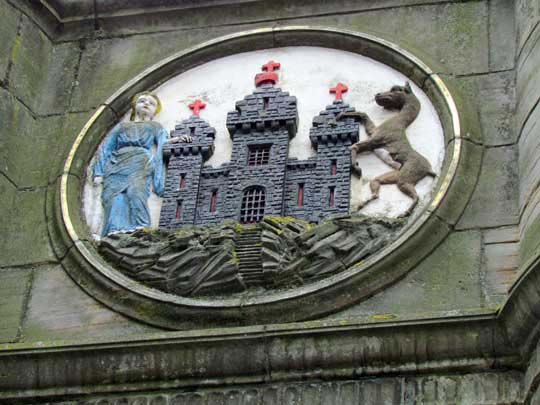
We
leave the tower for our first stop
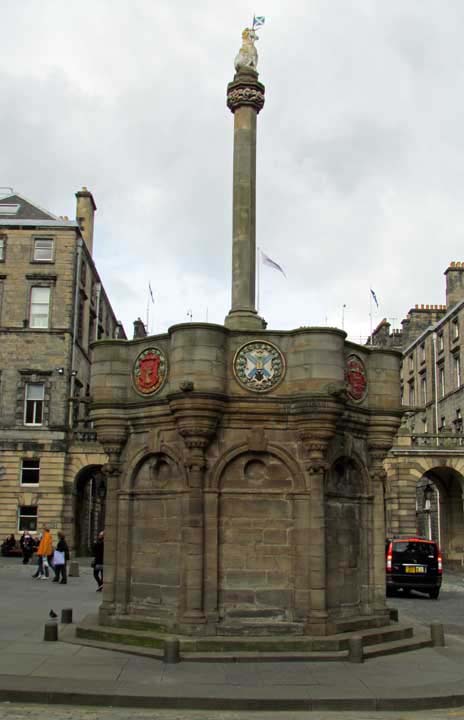
Behind
the tower stands an old Parliament building. It is currently used as law
offices. It contains the famous "strolling room".
(Pictures were not allowed inside.) This room is perhaps 100 feet long and
30 wide. Lawyers and heir clients, partners or associates, leave their
office and walk side-by-side up and down the room as they very quietly, and
privately, talk. Visitors are not allowed to speak a word in this
room. While we were there, two pair of lawyers and their accompanists, were
pacing he room. Until lately, female lawyers were not allowed to walk the
room as their high heels made too much noise.
These
Sphinx-like figures grace the top of the walls.
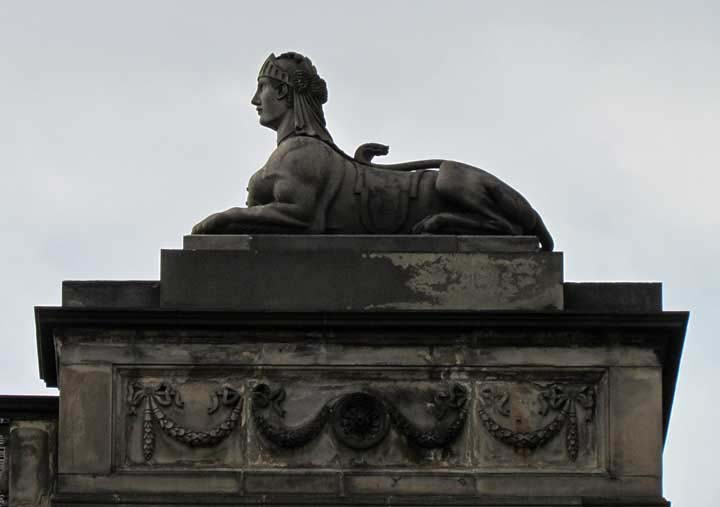
In
the middle of what is now the closely guarded reserved parking area next to
the old Parliament Building is a statue of a past Mayor of Edinburgh - placed
there by that Mayor. For some reason, he saw himself as a Caesar like
figure. Ego much?
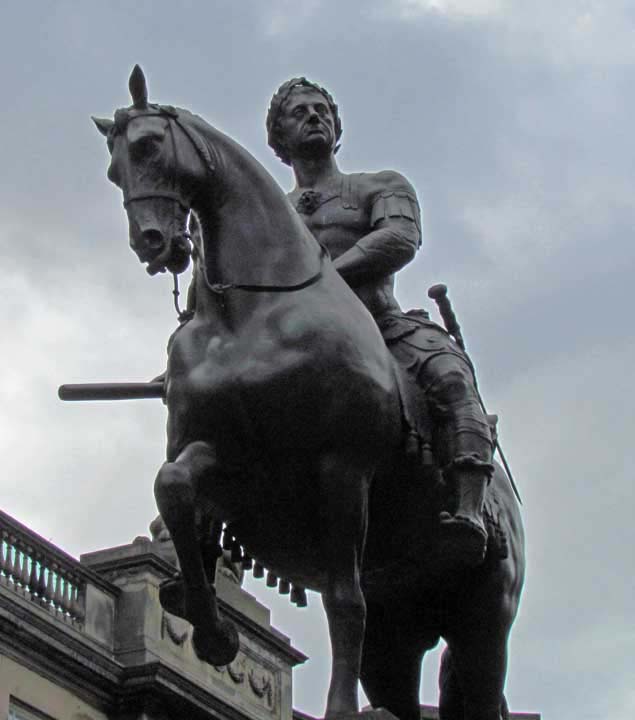
On
the street, in front of the old Parliament building is St. Giles Church. The
area that is now a parking lot was the Church's cemetery. The graves were
removed and placed within the church so the parking area could be paved - EXCEPT
for one grave - more on this later!
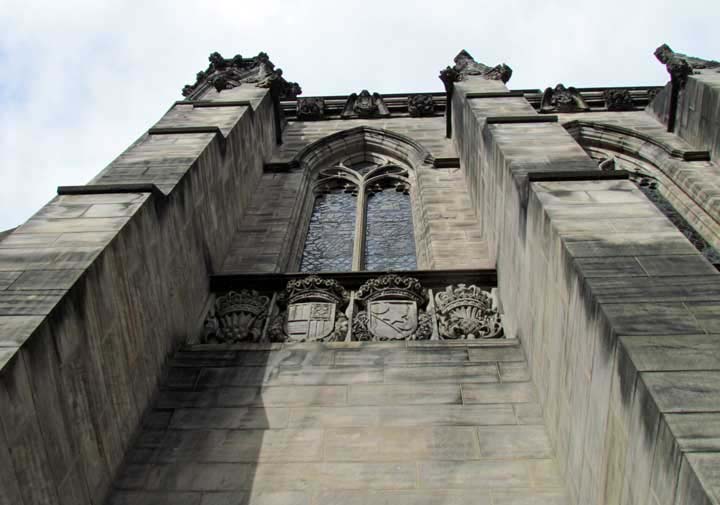
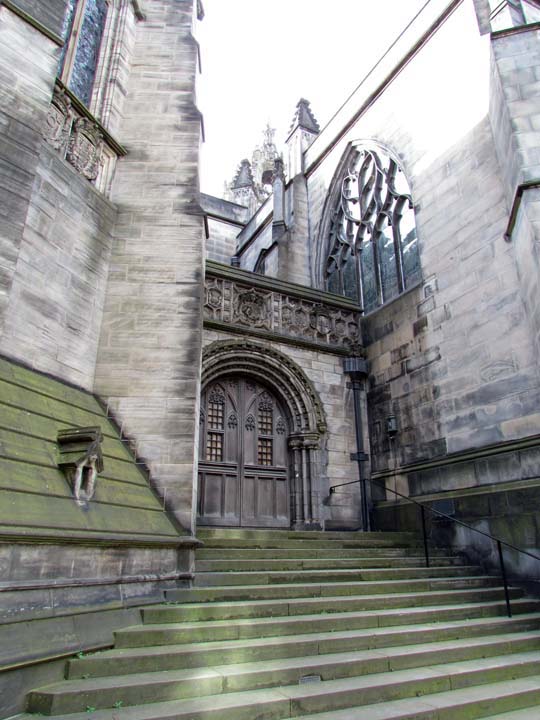
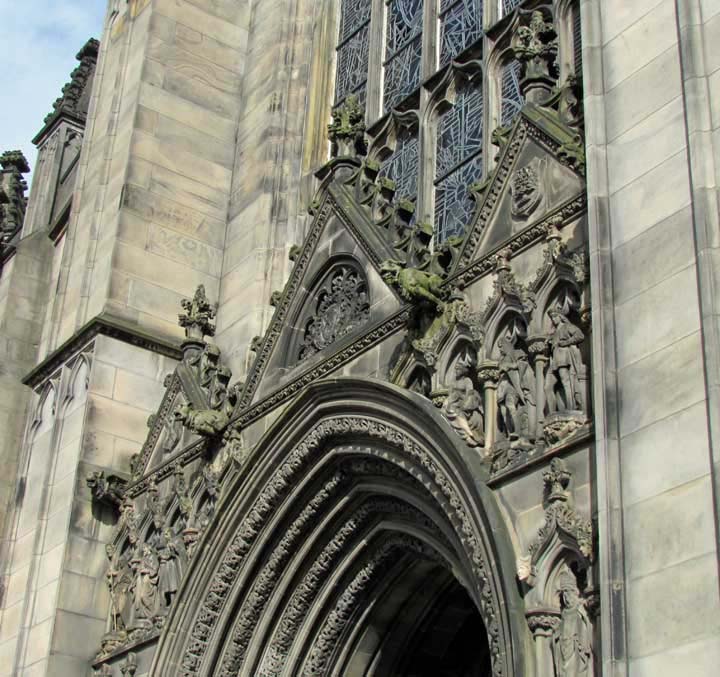
The
church has these very small stained glass windows which caught my attention.
Small works of art.
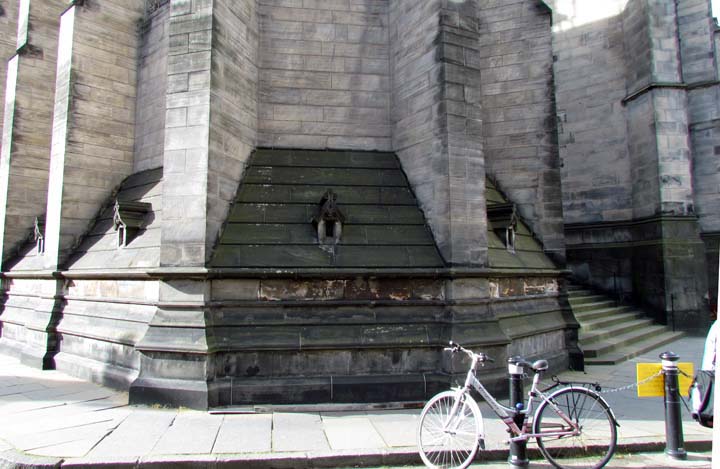
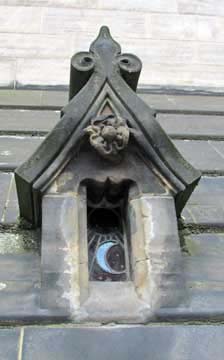
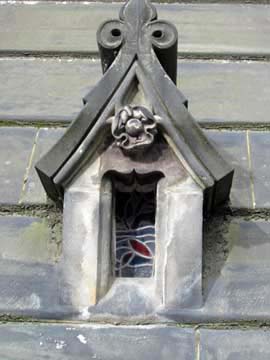
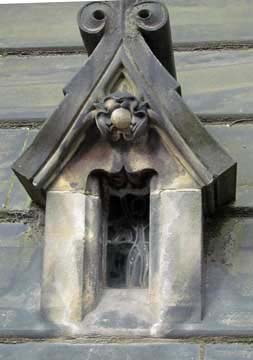
I
saw this small plant struggling to grow out of the church wall -
ended
up being one of my favorite pictures
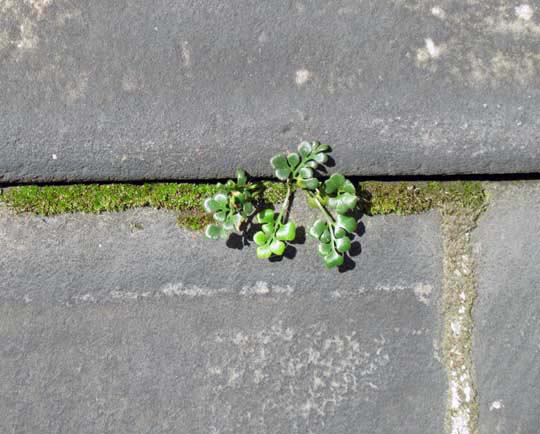
The
Parliament Building was burned down. The central and left-hand wing, now
used as law offices, was rebuilt exactly like the original building. Money
ran out and the right-hand wing is only an exterior. The inside is
empty. Over that wing's door is one of the original Parliament pieces,
still showing burn marks.
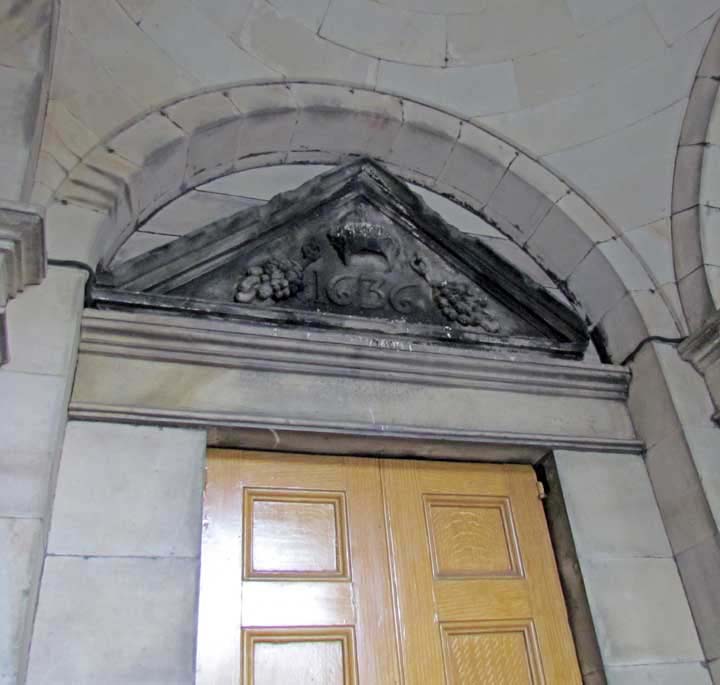
On
the side walk are preserved markings , carved in granite indicating where some
buildings, now gone, were in relation to the street. Gone are the
gallows and the jail.

By the West Door of St Giles' is the
Heart
of Midlothian, a
heart-shaped pattern built into the settled road, marking the site of the Old
Tollbooth, formerly
the center of administration, taxation and justice in the Burgh. The prison had
been described by Sir
Walter Scott as the "Heart of Midlothian", and soon after demolition, it
occurred to the city fathers to place a heart on the site. Locals still spit on
the Heart (aiming very specifically for the center). The legend has been
"cleaned up" by tourist guides who claim the spitting is for good
luck, but it is really the same as it was, a good old-fashioned disrespect for
authority.
The
jail was much hated. When the past citizens of Edinburgh waked by the
original jail, they would spit on the first step of the jail to show their
contempt for England, corrupt officials and false imprisonments.
The
jail may be gone, but the tradition continues. As citizens of Edinburgh
walk by they spit on a heart shaped set of pavers which are the site of
the original steps of the jail.
As
we walked by, several times, we could vouch that the tradition has not died.
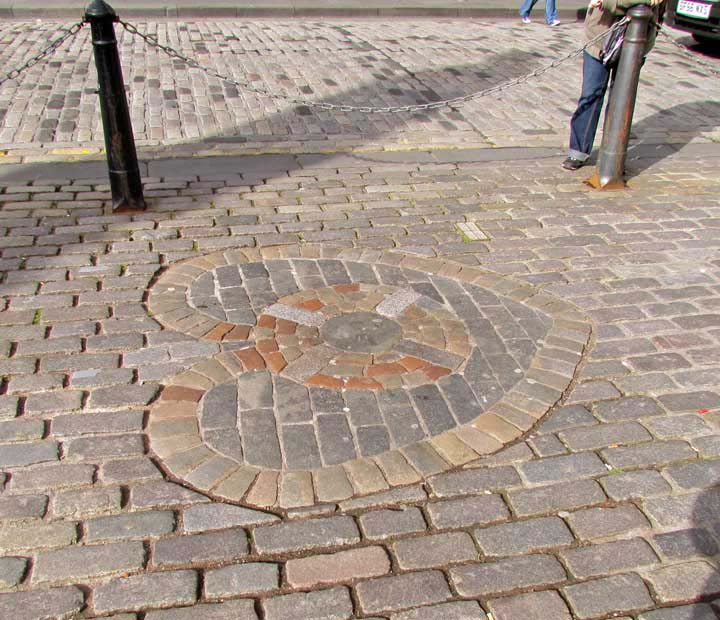
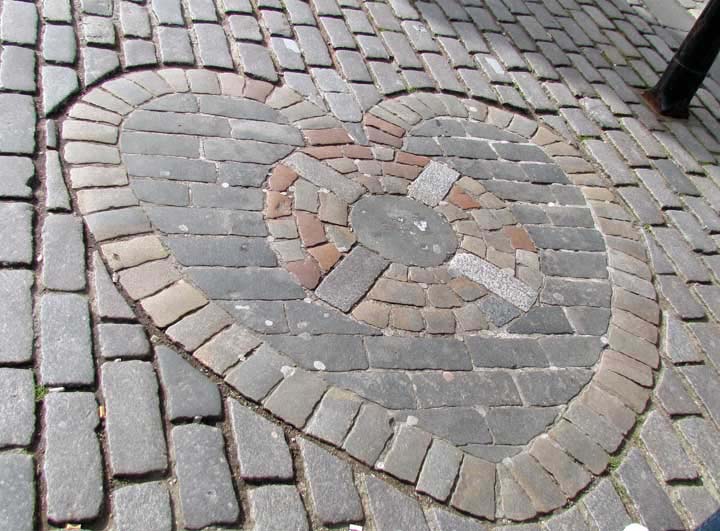
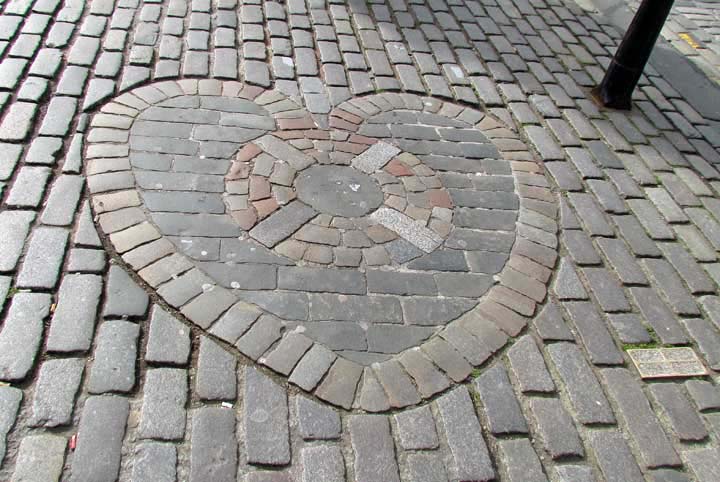
Our
tour guide took us to our first Close
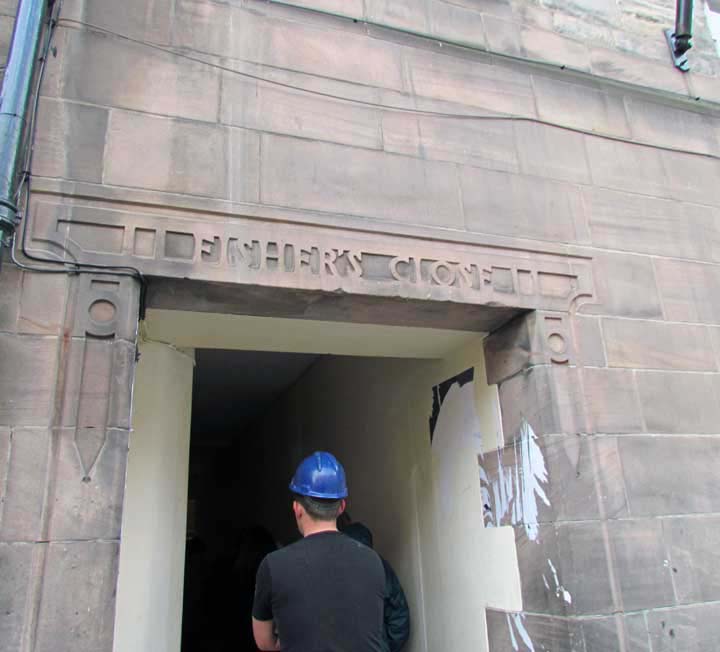
This
one is being refinished so the hallway's stone face has been dry walled,
however,
you can see how narrow it is
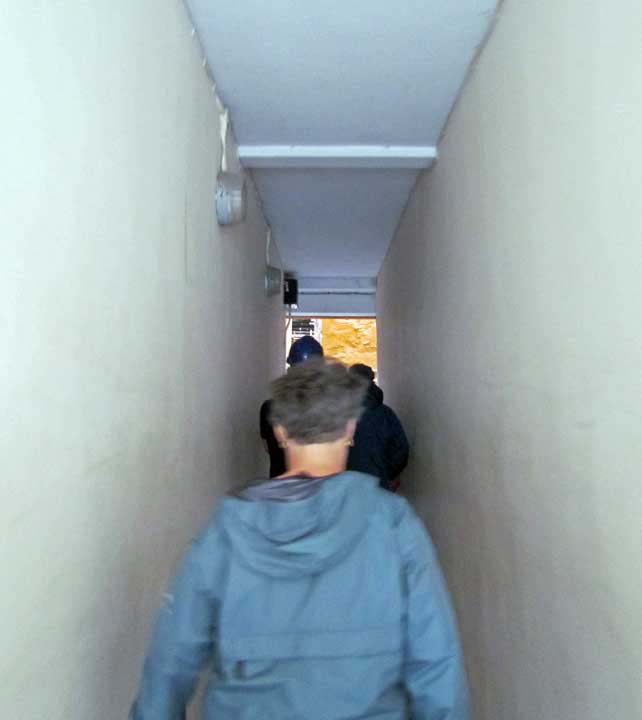
Because
everyone wanted to live within the walls of what is now Old Town, the homes on
the close's had to build up - there was no more land to build upon. As you
see, this one is 6 stories high. Some were known to be 14 stories.
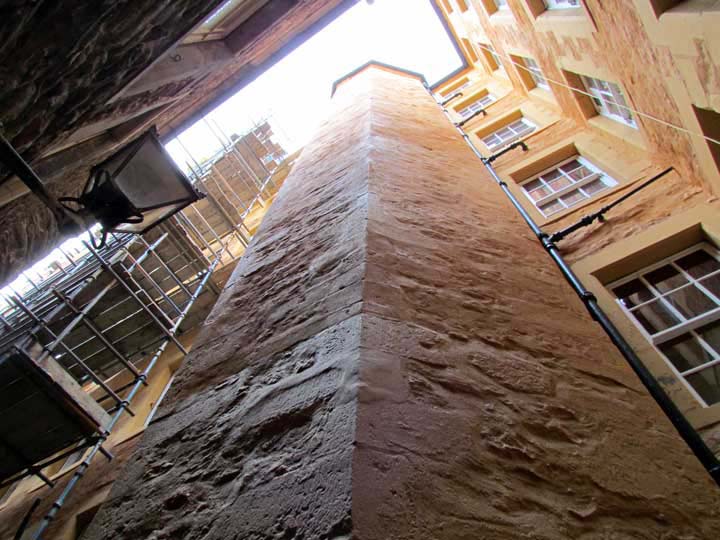
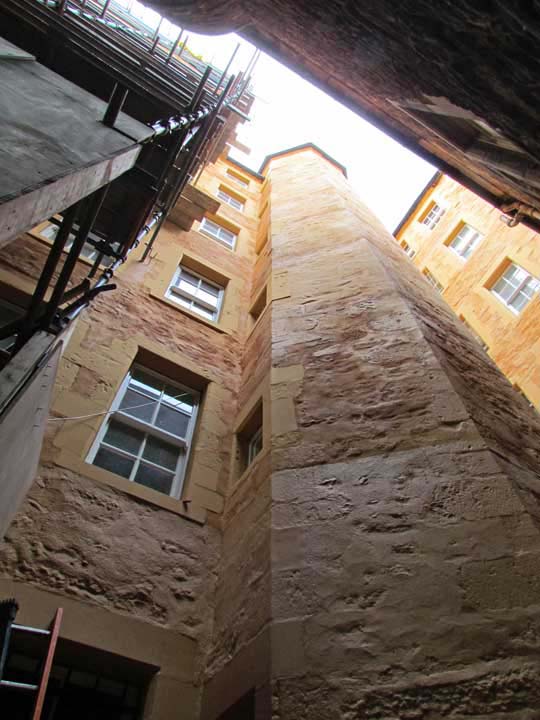
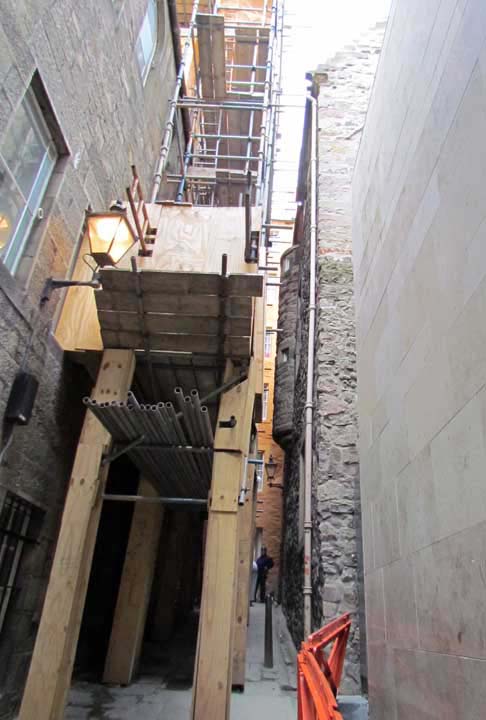
We
go further down the Royal Mile
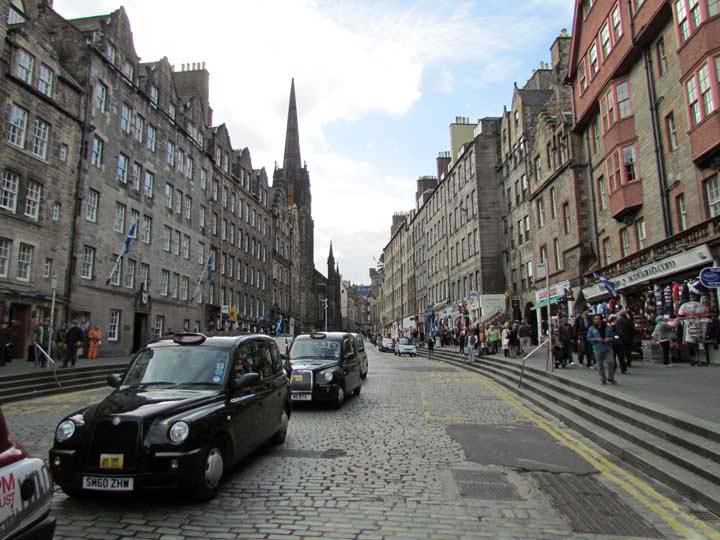
And
into another Close
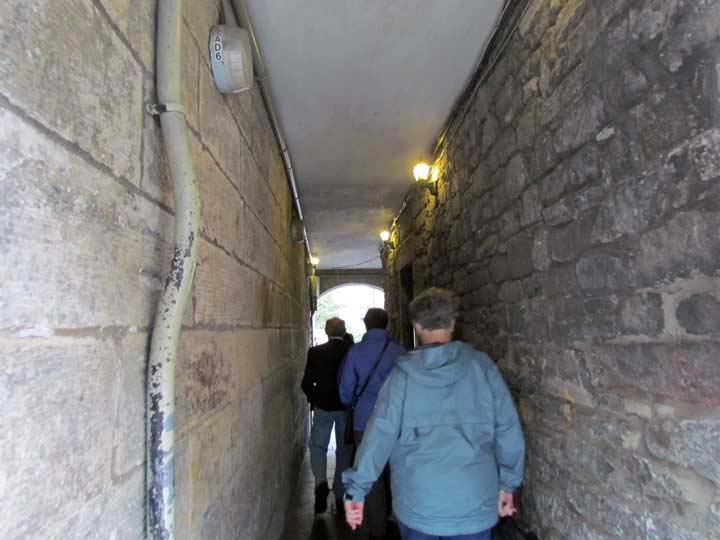
The
very rich and famous paid extortionate costs to build and live in courtyards at
the end of shorter Close's. They had guards attempt to keep others out,
and had very strict rules regarding waste placement and removal.
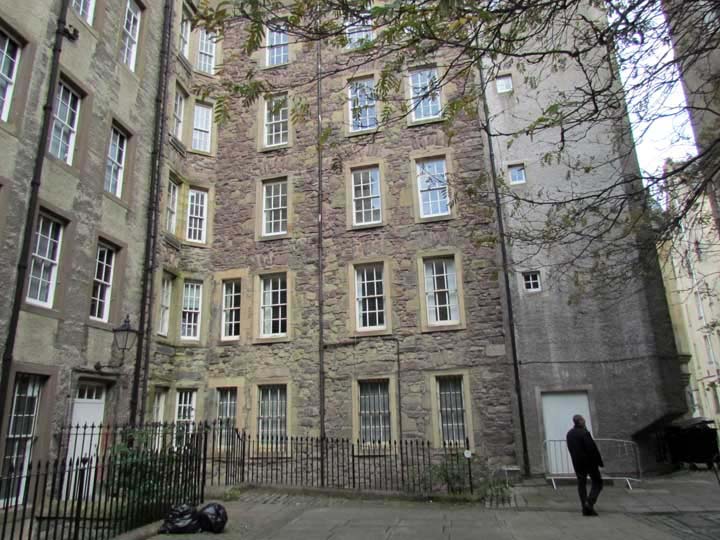
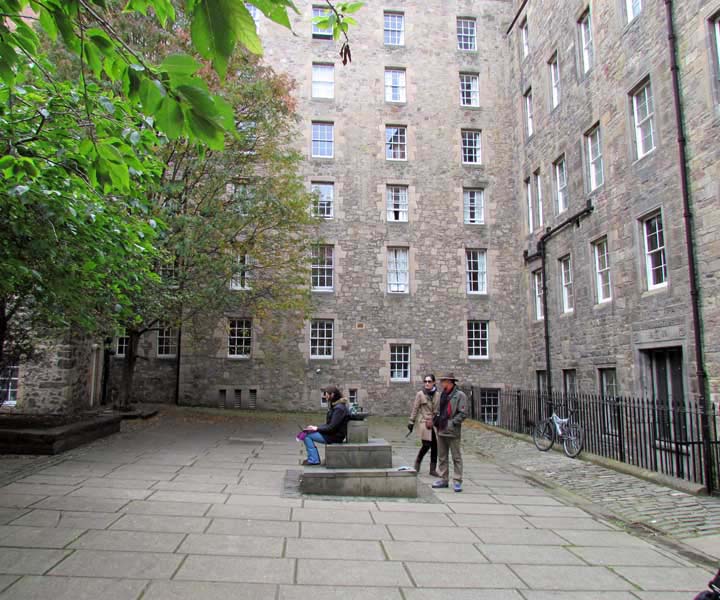
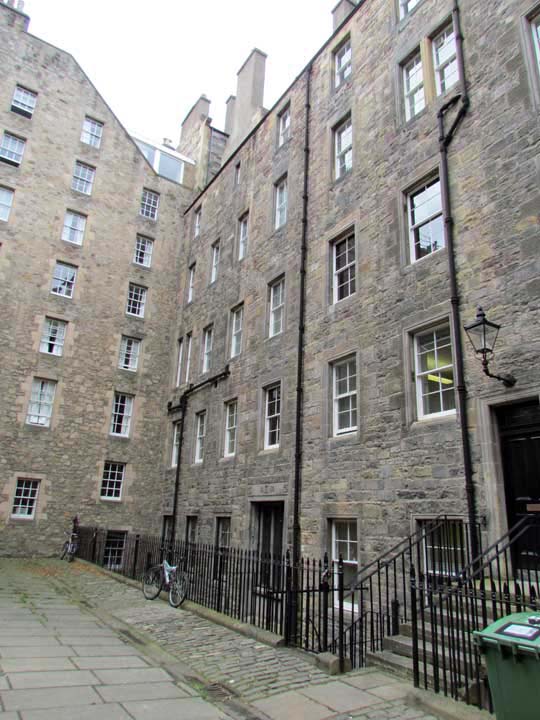
This
courtyard was home to famous writers and intellectuals. At the lower
corner one finds the Writer's Museum. Sir William
Grey originally built and owned this building with
his wife. Their coat of arms is displayed prominently. The building
is a real treat to see when compared to the buildings along the Royal Mile or in
the Close's
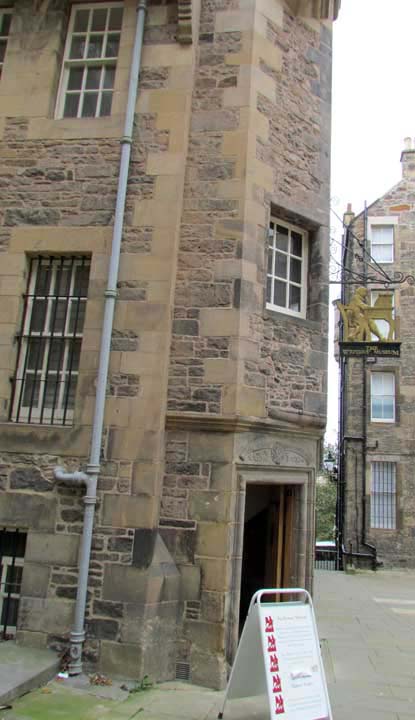
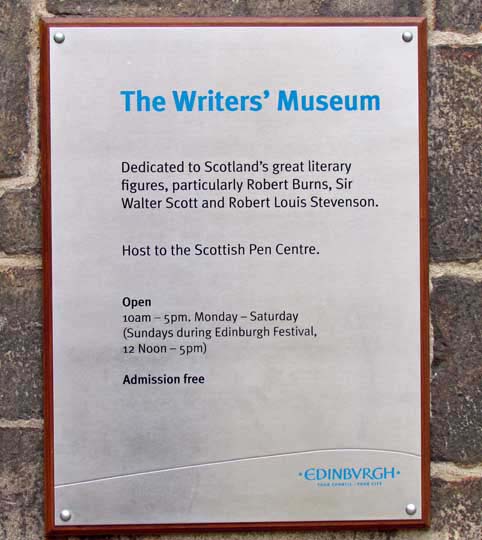
We
did not visit in the building, as we were on a walking tour, but the museum's
website says, "Visitors can see portraits, rare books and personal objects
including Burns’ writing desk, the printing press on which Scott’s Waverley
Novels were first produced, and Scott’s own dining table and rocking horse. We
have Robert Louis Stevenson’s riding boots and the ring given to him by a
Samoan chief, engraved with the name ‘Tusitala’, meaning ‘teller of
tales’. There is also a plaster cast of Robert Burns' skull, one of only three
ever made. Even if you’re not a bookworm, it’s well worth a visit."
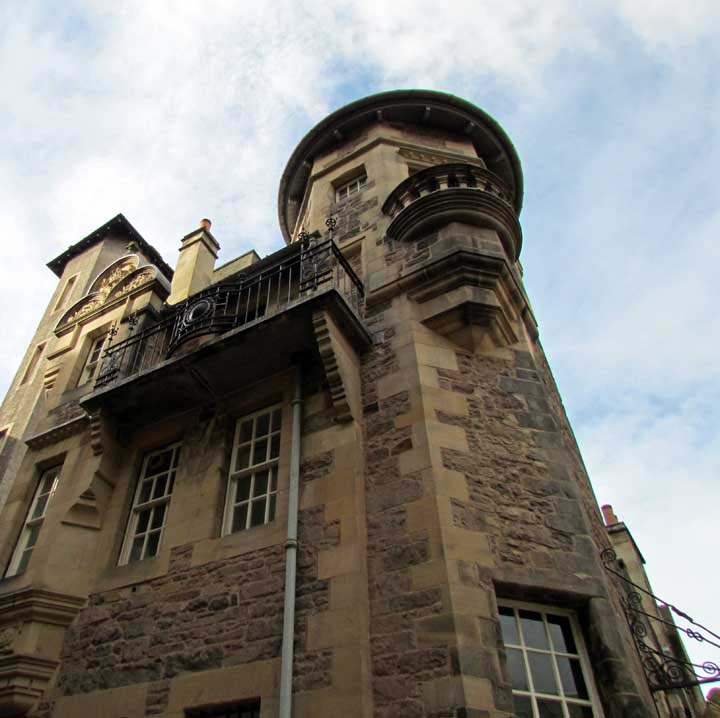
If
you look above the doorway of the Writers’ Museum you will see the
warning words ‘Fear the Lord and depart from evil’? You can also see the
initials of the first owner of the house, wealthy merchant Sir William Grey and
his wife Geida Smith.
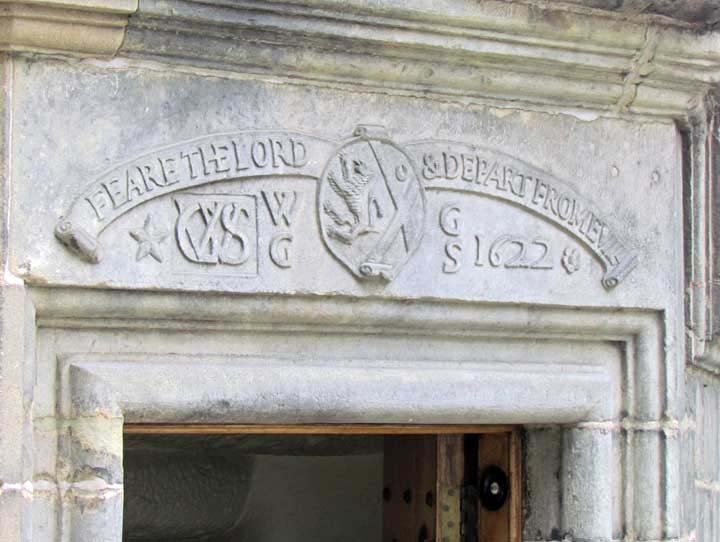
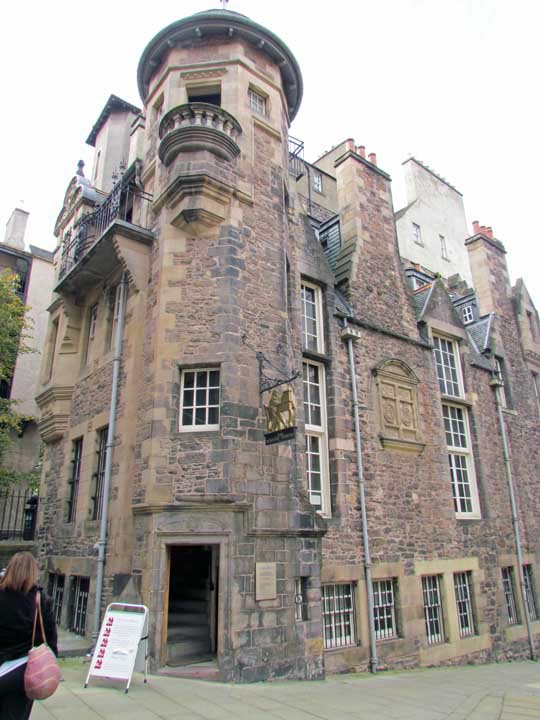
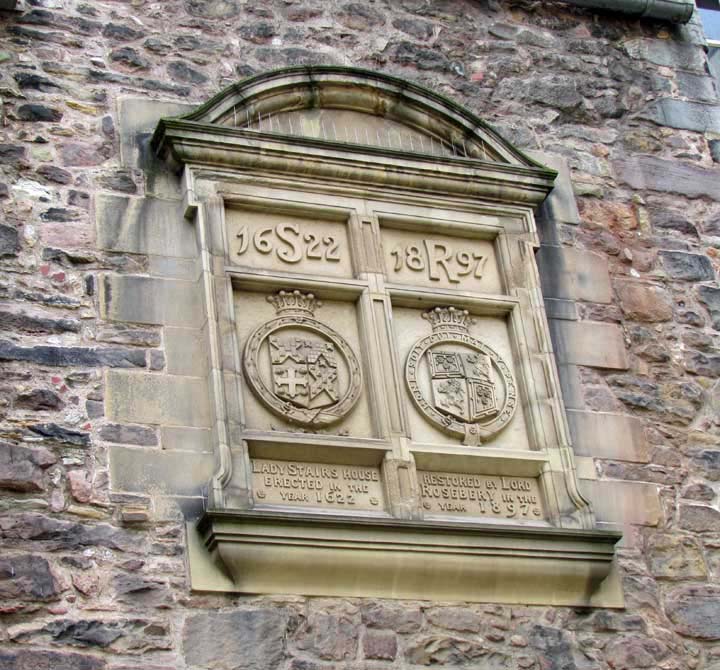
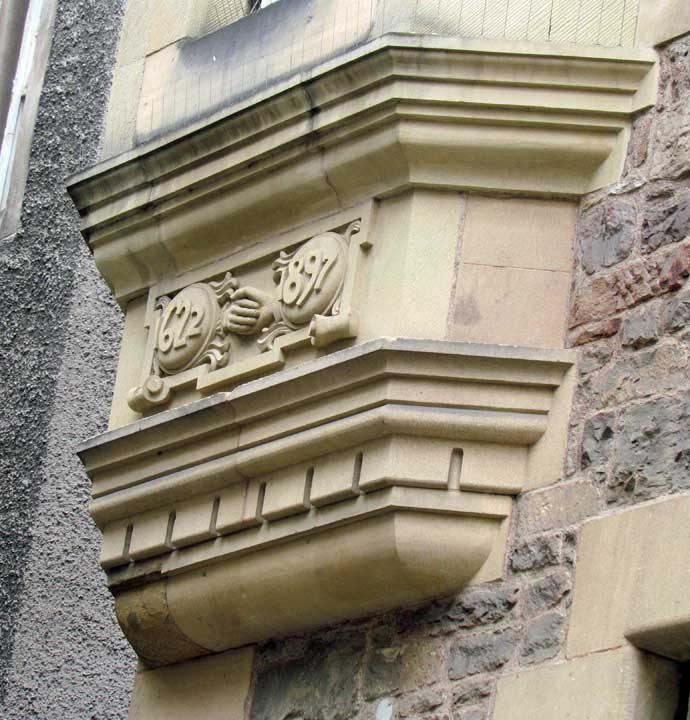
Another
unusual, and more modern building across from the museum
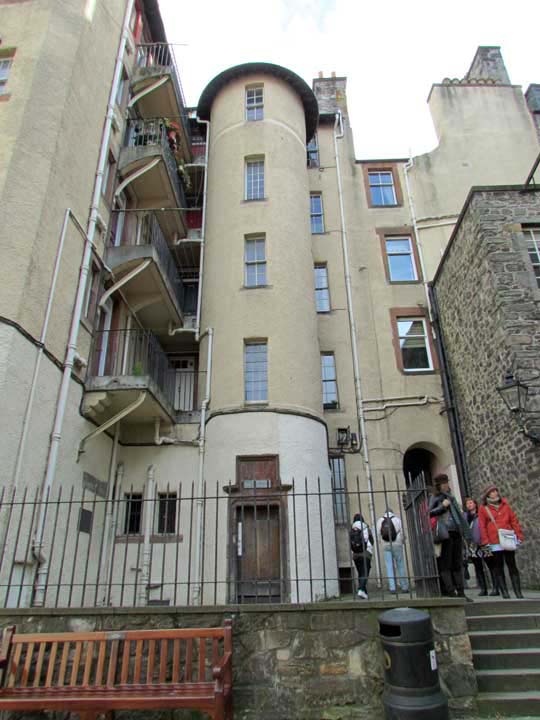
Views
of the courtyards

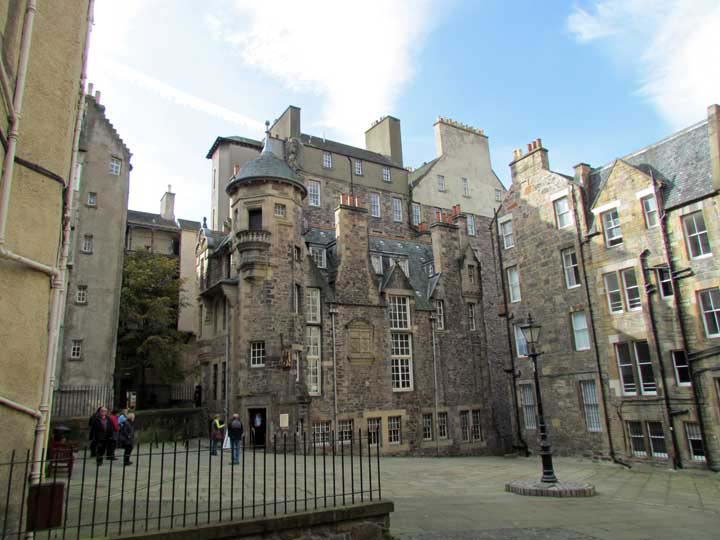
Looking
down a side street - no traffic is allowed on the Royal Mile
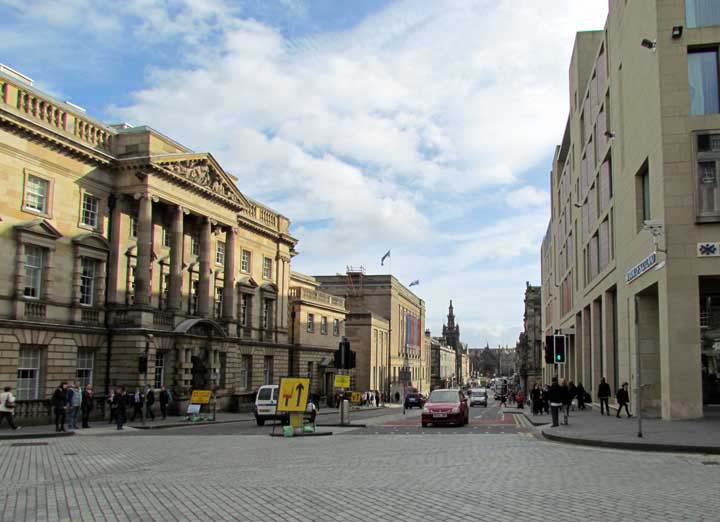
The
statue of David Hume
He
was considered so brilliant, and so able to take either side of a debate and win,
the tablet he holds is blank - symbolizing there was nothing for him to yet
learn
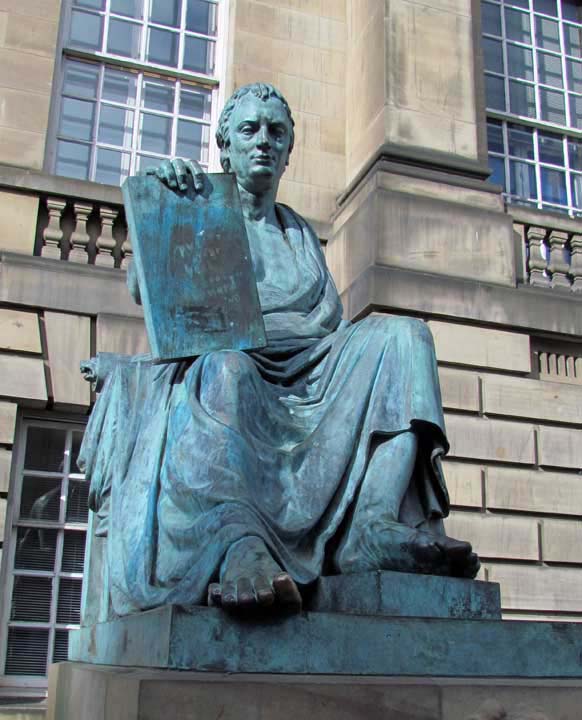
Because
he was so brilliant and his knowledge so deep, students, particularly law
students, rub his toe on his statue for good luck prior to exams.
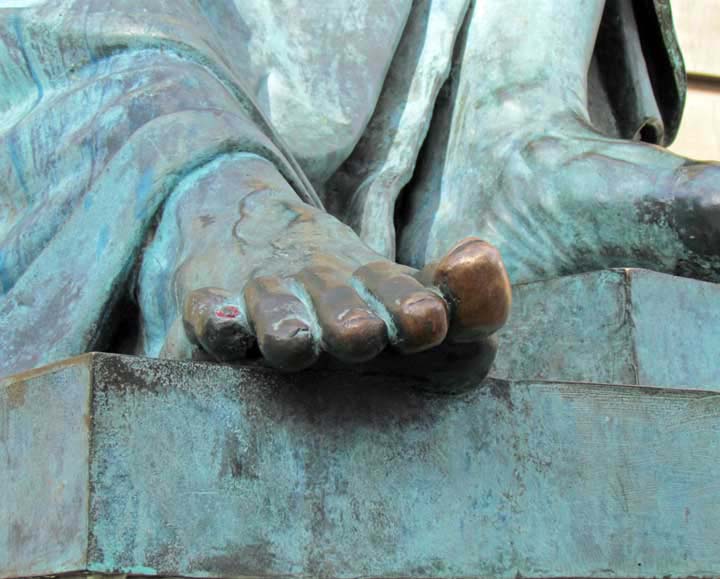
Different
views along the Royal Mile
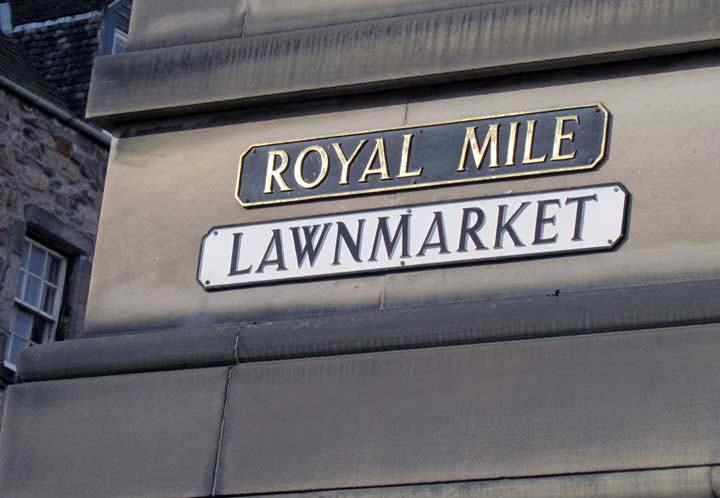
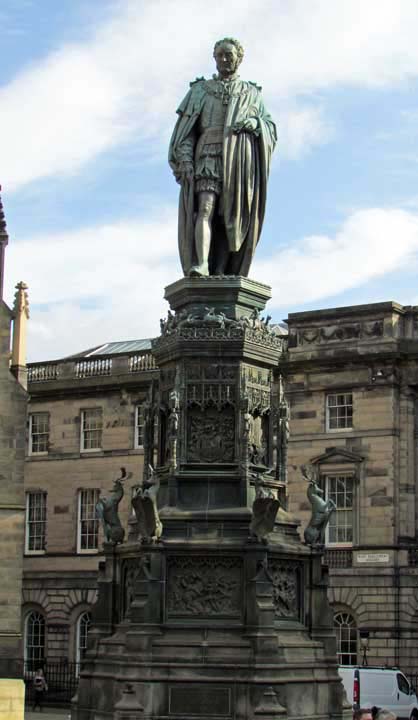
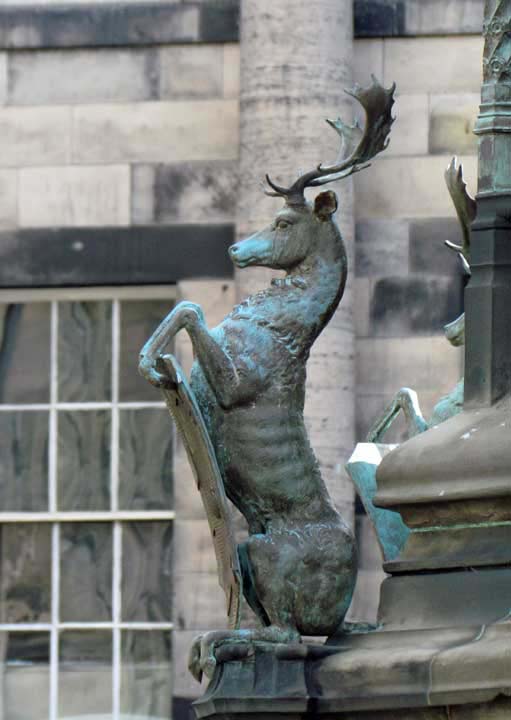
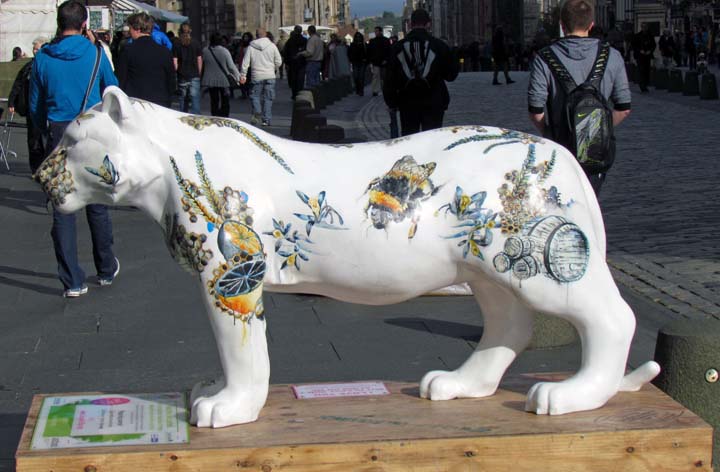
Jackie
walks down a close keeping up with our guide and group.
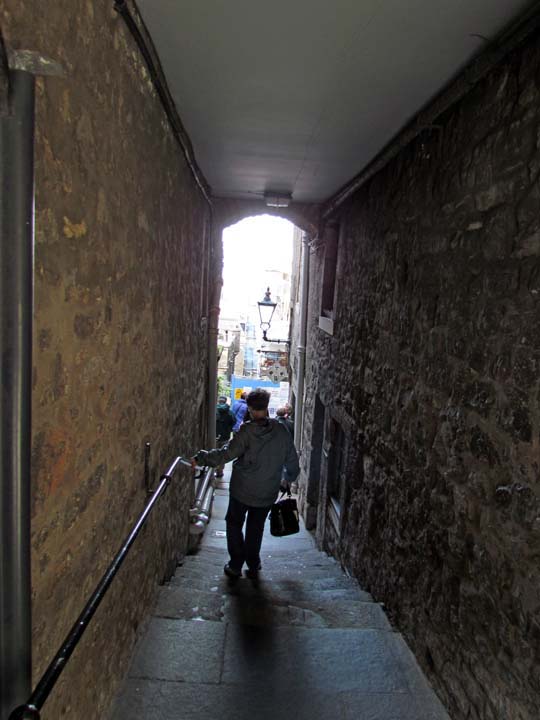
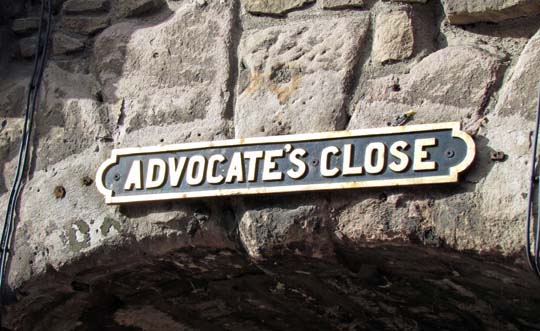
A
view from Advocate's Close of the Wallace Tower (in Edinburgh - not Stirling)
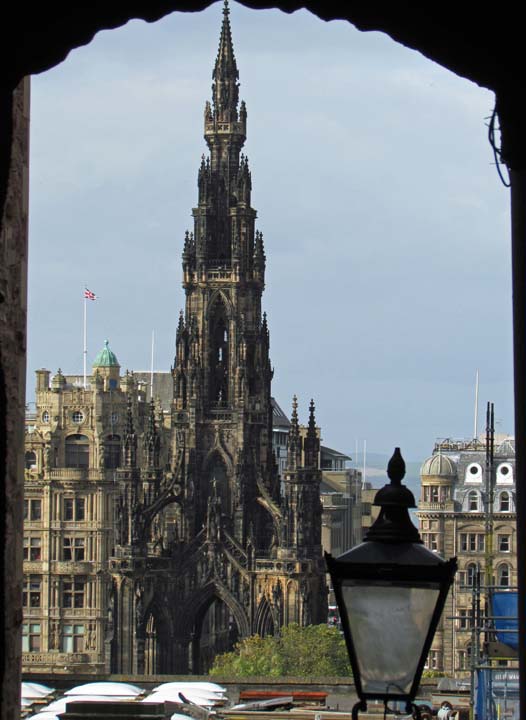
A pretty entrance sign to a close
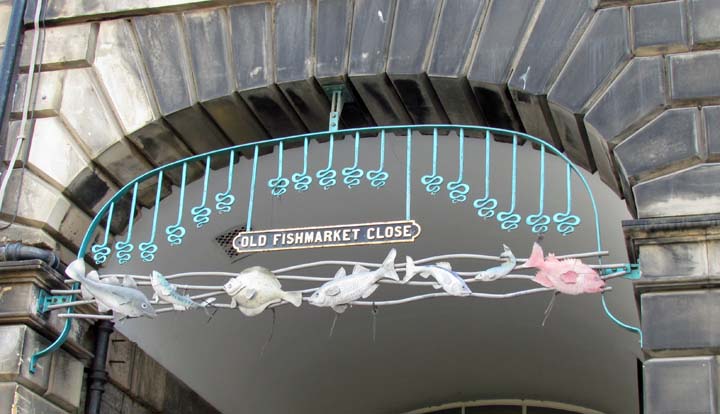
Statuary
is fairly rare along the Mile
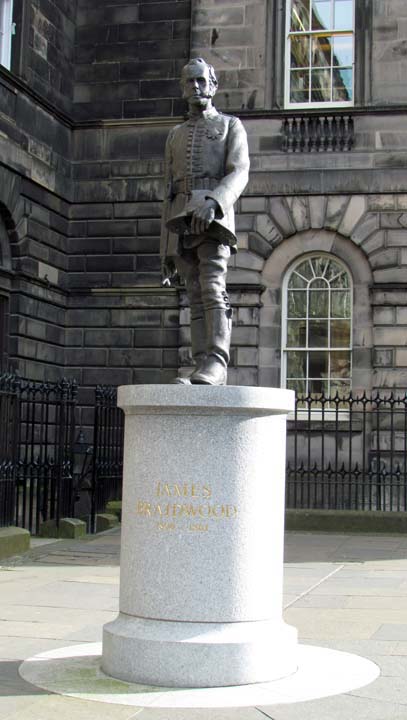
Ah,
the church cemetery paving story,
as
copied from http://www.planeteyetraveler.com
"The Burial Site of John Knox: Weird
or Sad, You Choose
John Knox was a famous Edinburgh resident who in his
duties as Scottish priest is considered the founder of the Presbyterian
denomination. He served as minister in the glorious St. Giles Cathedral from 1560 to 1572. Apart from his contributions to the reformation, he is
also widely known for his fierce oppositions to the policies of Mary Queen
of Scots.
Knox died here in Edinburgh and was buried in the St.
Giles graveyard. What’s that, you say? You couldn’t find the graveyard
at St Giles? Well, that’s because it was paved over. It’s now a parking
lot. Yes, the man who founded the Presbyterian church is buried under
parking space number 23. If you visit the church, from the pedestrian side
walk around to the back of the church and head for spot number 23. The
specific spot of Mr. Knox’s grave is denoted by a small, unremarkable and
wordless brass plate buried in between the pavement."
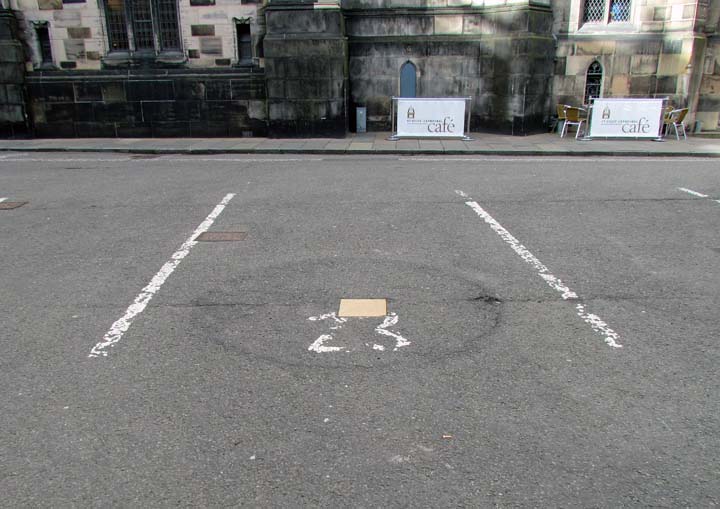
A
long narrow close - quite stunning
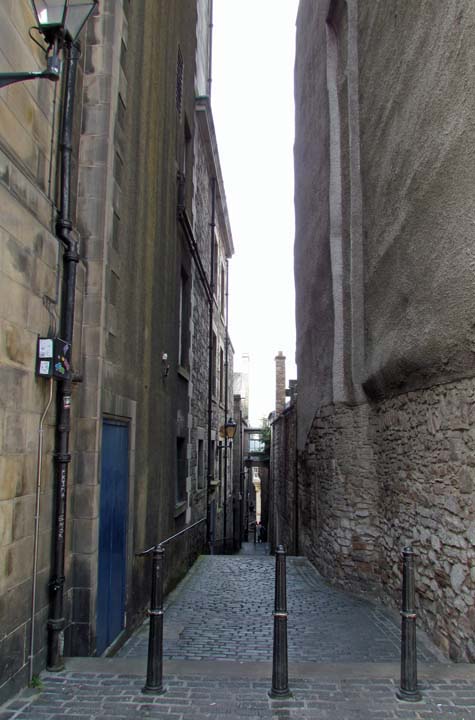
There
is too much history here to ever see and learn on any one visit - or in our case
- two visits. History is virtually everywhere. You have to look in
every nook and cranny, and then you'll still miss much.
For
example, out of curiosity, we just happened to look down a close that was half hidden
by table and chair in from of a eatery.
What
we would have missed if we hadn't seen this simply by chance!
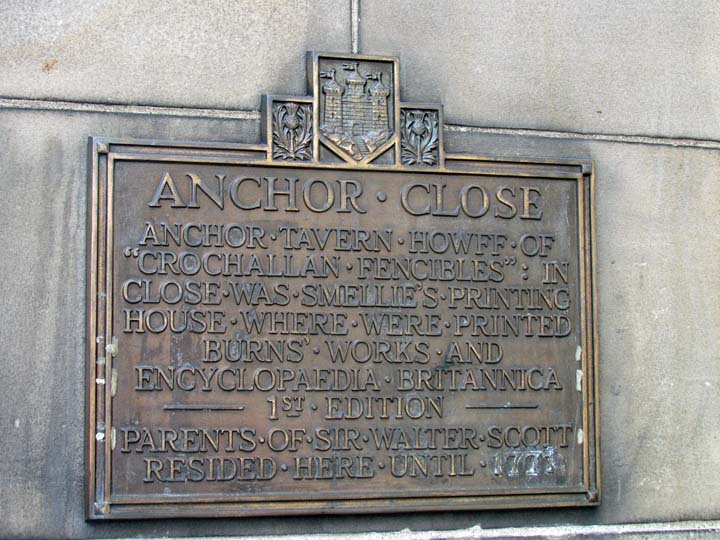
We
cut through Fleshgmarket Close to the street back to the train station.
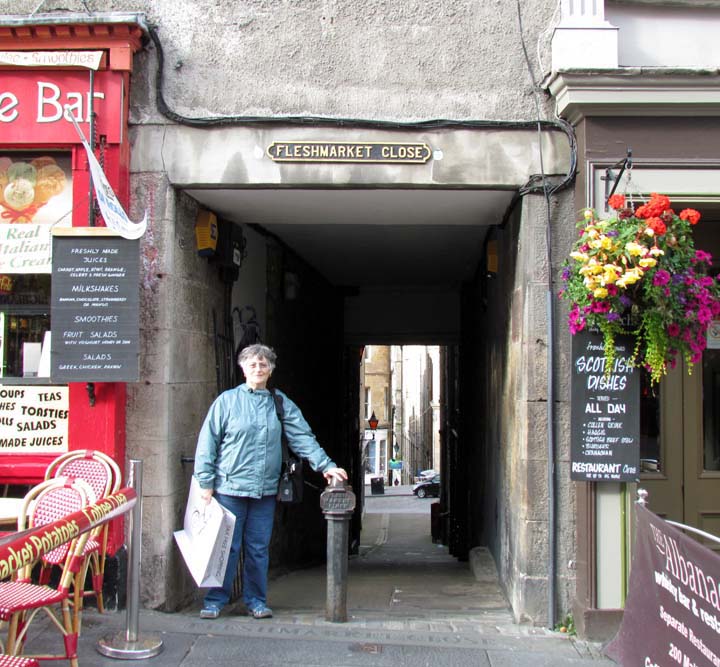
As
we go down the street, serenaded by a group of perhaps ten young men, traveling
together and feeling no pain in a tavern we spot a shop across the
street. Actually they were quite amusing as they waved me over to join the
singing. Not knowing the song, nor the borough, I applauded and
declined.
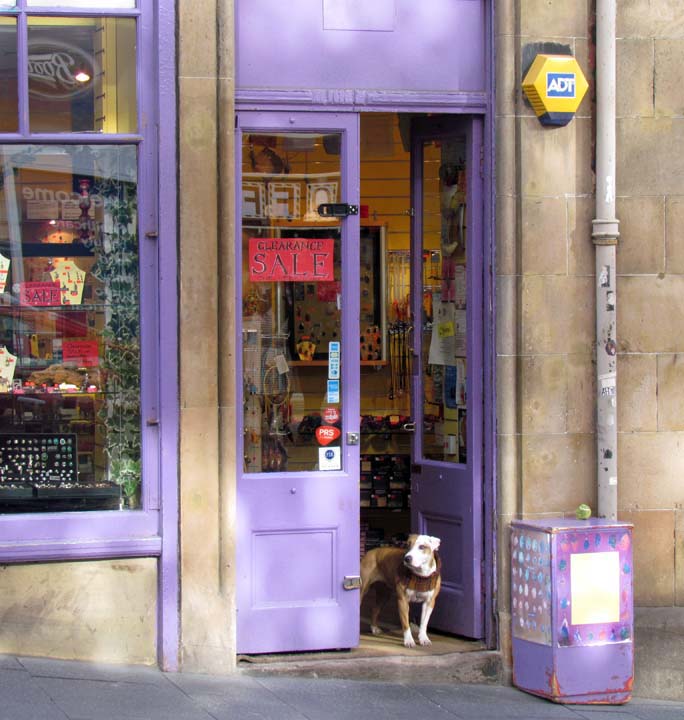
Yes,
the dog guarded to shop door -
Clad
in his tartan!
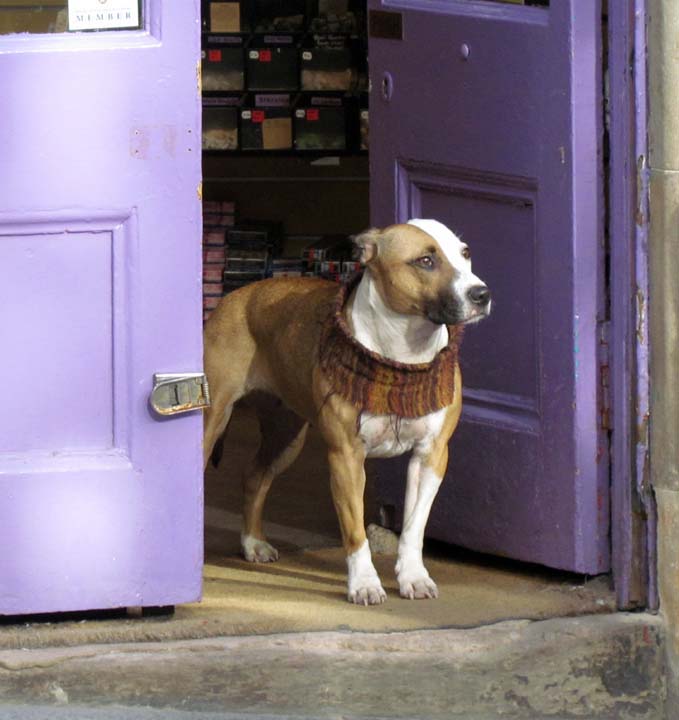
Last
wildlife on the way to the station
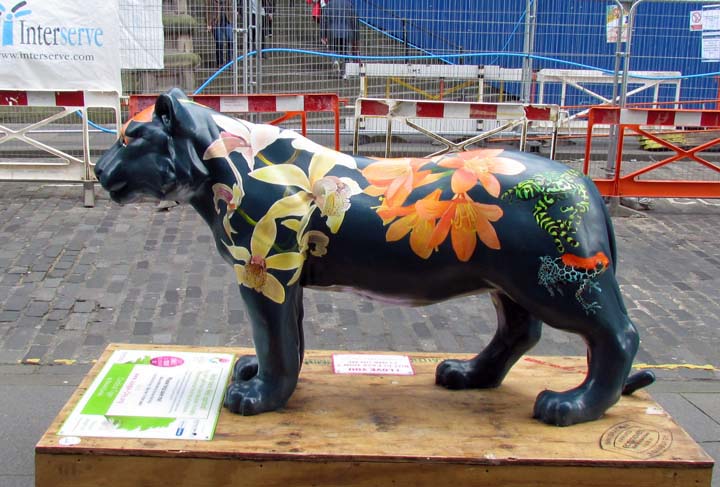
After
getting back to our car, we hunted for a place for dinner. Our guidebook
listed one of the best places for pub food
So we
drive in circles, even with the GPS, to find this pub. We were going
the wrong way on the street (meaning opposite way, I WAS on the right side as
required) so we U turned and parked. Directly across the street was an old
stone building. On the second floor there was a cat looking out the
window, sitting straight up with its tail curled around its feet. I thought it a
plush toy. I walked closer and closer and finally saw it was
breathing.
I ran
across the street for my camera and, of course, it had moved from that perfect
pose. None-the-less, I think I got a couple cute pictures, AND found an
other "accidental" historic site.
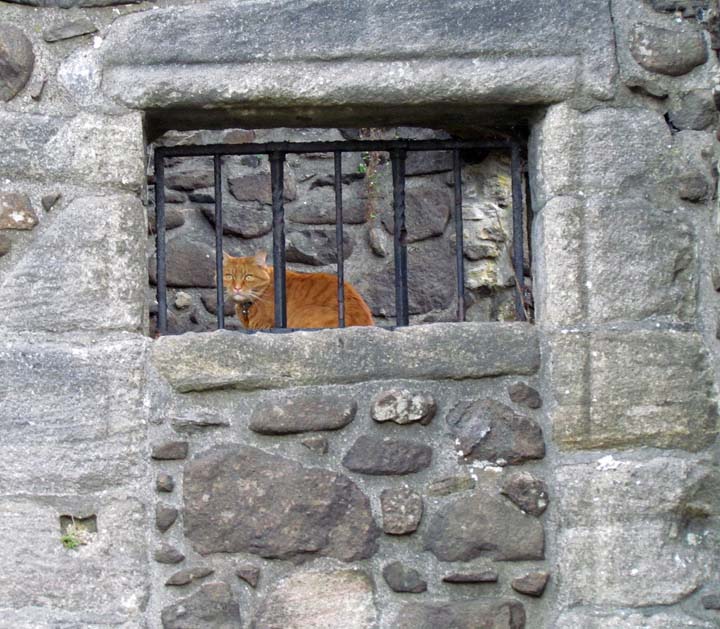
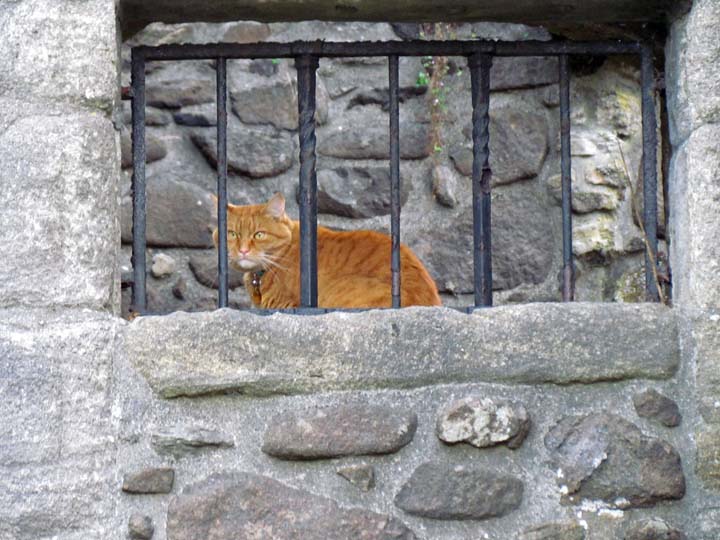
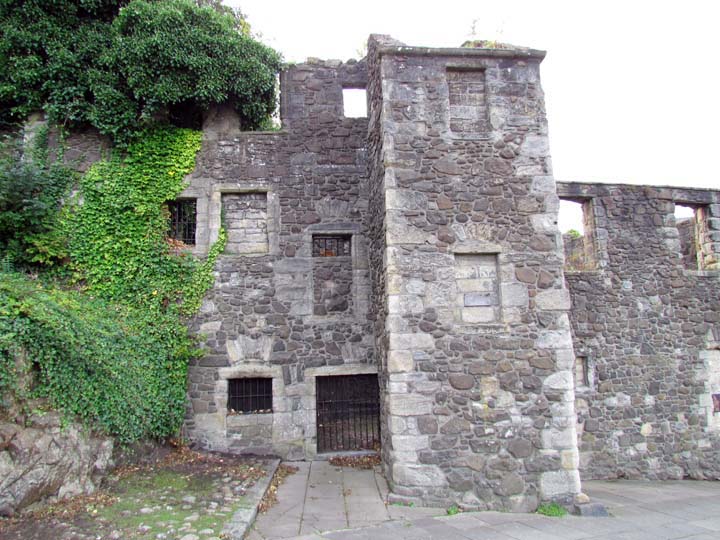
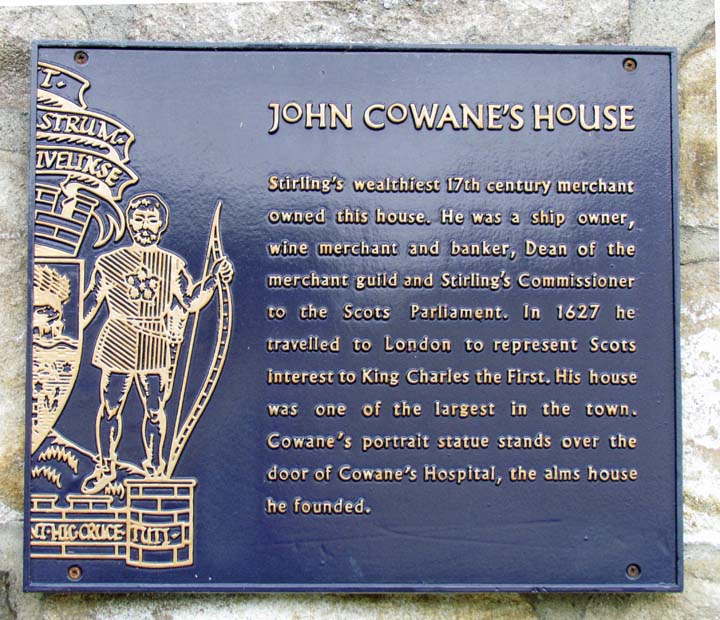
Oh,
we did find the damn pub - with a sign, "We've reopened under new management".
We went in to discover this was their second day of business after the first
owner left, 6 months ago. Had no food. We left for Stirling.
~ ~ ~ ~ ~ ~ ~ ~ ~ ~ ~ ~ ~ ~ ~ ~ ~ ~ ~ ~ ~ ~~ ~ ~ ~ ~ ~
~ ~ ~ ~ ~ ~ ~ ~ ~














































































